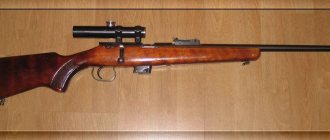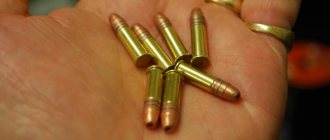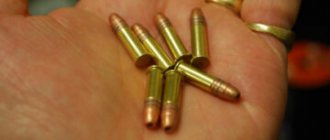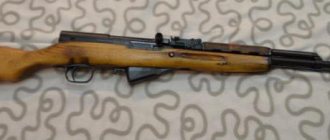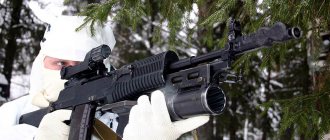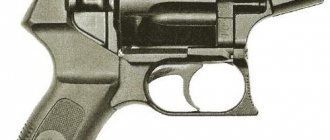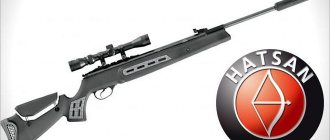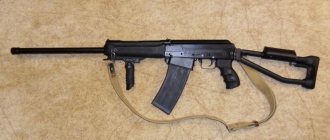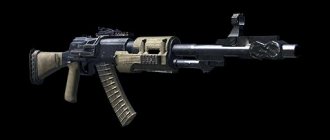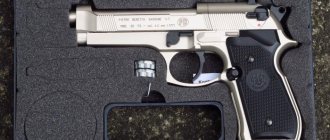- May 7, 2019
- Weapons and ammunition
- Natali Michaelis
Simonov's self-loading carbine is one of the most popular “tools” for hunting. This trend has been established thanks to relatively inexpensive ammunition that has remained in warehouses since the Great Patriotic War. The rifle is designed to fire 7.62 x 39 mm caliber, but similar ammunition differs in design and technical characteristics. We'll talk about which cartridges are best for SKS in our article.
Using a carbine for hunting purposes
The Simonov self-loading carbine is a weapon that has been extremely popular among commercial hunters for more than 60 years. Large stocks of rifles and ammunition for them caused a real resonance among Russian hunters. This was especially observed after the first models with tuning went on sale.
Modifying the SKS at home has become a fairly popular activity among many owners of this weapon, because the rifle is an excellent platform for tuning. Although for hunting animals it will be enough to install an optical sight and a modified magazine for 20 rounds on it.
The SKS uses standard military ammunition, which provides good stopping power and accuracy. The carbine performs best when hunting medium and large predatory animals. The destructive power of the rifle will be quite enough to kill an adult wolf, boar and even a bear.
For hunting birds and small fur-bearing game, a rifle is used much less frequently, although this type of hunting also takes place. Some hunters use a rifle to hunt particularly shy geese, ducks, hares and foxes. It will be enough to know the behavioral characteristics of the prey, as well as what cartridges are best to shoot it, so as not to seriously damage the trophy.
Modifications of carbines based on SKS-45
The SKS-45 carbine has several official modifications developed by the Tula Arms Plant. However, only 4 of them are most popular among hunting enthusiasts:
- OP-SKS. A distinctive feature of this carbine is that it does not have a bayonet, as well as a place for its fastening. The standard sighting bar was modified so that aimed shooting could be carried out from a maximum of 300 meters.
- TOZ-97. A variant of a hunting rifle, which was obtained by installing a PO-4x optical sight on a Simonov carbine. The body was also slightly changed - now the weapon is supplied in a plastic version.
- VPO-208. A smoothbore modification using .366 TKM cartridges for firing is produced. There is a hole on the muzzle of the barrel for installing a compensator.
- SKS-366-Lancaster. Another modification chambered for .366TKM, manufactured by rotary forging. It differs from the previous version in the increased barrel length, and also in that the bayonet mount cannot be sawed off.
Hunting modifications primarily attract buyers with their reliability, as well as the fact that they are designed specifically for hunting. However, such a weapon will cost a little more than the standard SKS-45.
What ammo can I use?
As mentioned earlier, SKS 7.62 x39 cartridges were produced back in 1943, when our country was occupied by the Nazi invaders. Of course, at that time, engineers did not even think that one day this type of ammunition would be used for hunting. The only requirements for the cartridges were proper operation and good ballistic properties.
There are four main types of such ammunition:
- Ordinary. They use a classic steel bullet, which does an excellent job of destroying enemy personnel. The ballistic projectile is capable of hitting targets that are located in open areas or behind easily penetrated obstacles (wood, plywood, etc.). The bullet shell, like the core, is completely steel, but the distance between them is filled with a special lead jacket. The cartridge has no distinctive coloring.
- Tracer ammunition used to adjust allied fire and target enemy locations at a distance of up to 800 meters. The core consists of a cup with a pressed-in green tracer compound, and also a special alloy of antimony and lead. After hitting a solid plane, the ammunition splits and tracer paint marks the building in which the opponents are located.
- Armor-piercing incendiary cartridges. This type of ammunition has a special composition that includes flammable liquid. Such a bullet is intended to destroy enemy personnel located at a distance of no more than 300 meters behind lightly armored cover. The shell has a tombac tip, and the core has a lead jacket. An incendiary composition is located in a special lead pan behind the core, which ignites when it hits a target. The head of the ammunition is painted red.
- Incendiary cartridges. Designed, as a rule, to destroy lightly armored enemy vehicles. To do this, you need to shoot the car in the area next to the gas tank, after which the flammable liquid will do the rest of the work. The structural difference from the previous type of ammunition is that the incendiary mixture is located between the jacket and the core. The head shell is made in red.
As you might guess, for hunting purposes it is allowed to use only conventional ammunition, and even if the legislation allowed the use of cartridges with flammable mixtures for hunting, there would be absolutely no point in this. Such a hunt will lead to nothing but a spoiled trophy. In the following sections we will talk about these varieties in more detail, and also talk about some modifications of the classic cartridge that are approved for use in hunting.
MAKSIMOV.SU
Yuri Maksimov, Mikhail Dragunov
photo by Yu. Maksimov
In Russia and the countries of the former Soviet Union, the 7.62-mm SKS carbine mod. 1945 is one of the most common types of hunting rifled weapons.
Its popularity is due to several obvious factors: the low price of this self-loading weapon, good ergonomics, sleekness and a certain elegance of form, high reliability and availability of ammunition.
SKS. The carbine is equipped with a hunting stock made by S. Ivanov
Here too
You can add the constant availability of inexpensive original spare parts on the weapon market and a growing range of accessories for modifying the Simonov carbine. Many people are also attracted by the legend of this carbine: the SKS is not only still a weapon of the Honor Guard, but also has a combat history - from participation in the battles of the Great Patriotic War (samples from the experimental batch) to a huge number of local wars right up to the present day.
Besides
Despite its undeniable advantages, SCS also has certain disadvantages, the material below will help you understand and eliminate them.
Various options for gripping the neck of the stock
when shooting from the SKS while standing handheld
History of the “skew”
Design features of the SKS
The pedigree of the SKS carbine dates back to 1938 -
to a prototype of the Simonov rifle, which participated in the competition, which resulted in the Tokarev SVT-38 rifle being adopted for service. Therefore, in the design of the SKS, solutions characteristic of the 1930s are clearly visible.
This is, firstly,
the most common locking scheme at that time was a skewed bolt. A similar principle was used on the Tokarev rifle, on Czechoslovak machine guns - ZB-30 (BREN), ZB-53 (easel machine gun), on the ZH-29 rifle. John Garand, who at that time turned to the bolt-locking scheme, to some extent looked like a “black sheep”.
Although
It is worth noting that automatic weapons, operating on the principle of removing powder gases and locking by turning the bolt, appeared literally at the dawn of the era of automation: it was on this principle that the first serial self-loading rifle was built - the Mondragon system. Apparently, the skew of the shutter has attracted attention due to its greater manufacturability: inclined planes are easier to produce in mass production than helical surfaces.
A fighter of the 128th Guards Rifle Division with the SKS
during the anti-Soviet armed uprising in Budapest. Hungary, November 1968
To the mechanism with a skewed shutter
When locking, there was a drawback such as “wedging”: the locking surface of the bolt frame presses on the mating surface of the bolt and presses the bolt against the guides, thereby creating additional friction force.
This problem was solved in different ways. SKS. Walnut stock option
The most radical solution
proposed by Czech designers, the Holek brothers, in the ZB-53 machine gun: the so-called “support platform”. During retraction, the bolt frame guides the bolt with a vertical platform, that is, reaction from the bolt to the guides is excluded.
And at the end of the run
the bevels on the side surfaces of the bolt run into the receiver rollers, the bolt moves from the support platform, and the locking surface of the bolt frame moves the bolt to the locked position. The locking mechanism of the Kalashnikov assault rifle works similarly; This is one of the design measures that ensures the highest reliability of the AK.
SKS produced by TsKIB in the late 1890s.
in a nut bed
On the FAL rifle of Dieudonné Seva,
the development of which also began before the war, the locking surfaces on the bolt frame and bolt are made of two stages. First, the section with a larger bevel angle works (less wedging), and when the moving system reaches the extreme forward position, then at the end the second section, with a smaller bevel angle, works.
Sergey Gavrilovich
The unlocking and locking surfaces are placed at different angles: the unlocking surface is made at an angle of 40 relative to the axis, and the locking surface is made at 60 degrees. By selecting the angle of inclination of the locking surface, Simonov was able to a certain extent to find a compromise between energy losses due to wedging when locking the bolt.
SKS carbine
compared to AKM assault rifle
Second -
this is an emphasis on mechanical (milling) processing.
A milled receiver, even a receiver cover (however, this is due to the fact that the bolt frame guides are made on it), a bolt frame with a bolt (which goes without saying), and the base of the trigger mechanism. SKS carbine compared to AKM assault rifle
Taking into account
Most of the samples of that time were built using this technology: Degtyarev machine guns, the already mentioned Czechoslovak machine guns, the M1 Garanda rifle. Only just before the start of World War II, German designers began to introduce stamped-welded structures: the MP 38/40 submachine gun and the famous MG-42 single machine gun (its development began even before the war).
Aues Doguchaev in the mountains of the KBR
hunts aurochs mainly with SKS
. That is,
from the point of view of “design ideology,” the SKS is a typical product of weapons thought of the 1930s. As an absolute asset, Sergei Gavrilovich should record the movement of the automation engine over the barrel, which he accomplished back on the ABC-36 (before that, everyone tried to hide the gas chamber in the forend, including J. Garand).
SKS and TOZ-BM -
an excellent set for all occasions
Alloy steels are already widely used in SCS:
The receiver liner, where the locking surface of the bolt rests, is made of 30ХН2МФА steel and hardened to a hardness of 44 - 50 Rockwell units.
The receiver itself
made of high-quality structural steel 50 - cheaper than 30ХН2МФА. Here the designer (apparently unconsciously) used an inventive technique, which in the theory of finding technical solutions is called the “principle of local quality.”
SKS with side rail, bracket and x3.5 sight manufactured by VOMZ
Steel 30HN2MFA
also used for the bolt and bolt carrier. The ejector and firing pin are made of steel 25Х2Н4ВА. These steels are still used in the weapons industry for highly loaded parts.
Alloy steels
began to be used in weapons production from the late 1920s: V.A. Degtyarev in his memoirs “My Life” recalled as something extraordinary the replacement of steel on the firing pin of a DP machine gun with chromium-nickel.
Hunting stock option
for SKS
SKS ejector spring,
working in difficult conditions (dynamic load and extremely limited space where it is located), wound from a three-core rope. A similar material is used for the AK and SVD mainsprings, as well as for the ejector springs.
Impulse transmission
from the gas chamber to the bolt frame is carried out through a two-link system: a gas piston moving in a gas tube - a pusher located at the base of the sight. In this case, the pusher (and through it the piston), after transmitting the impulse to the moving system, is returned to its original position by a powerful three-core spring.
For what
such a powerful spring was needed - frankly speaking, it’s incomprehensible. The pusher is returned to the SVD by a rather weak spring. All she has to do is return the light piston and pusher to the extreme forward position. By the way, an error when disassembling the SCS - excessive rotation of the gas tube fastening pins, which simultaneously limits the forward movement of the pusher, leads to the pusher “shooting” under the action of a powerful spring.
Since about 2015, hunting SKS
began to be sold not just with an unsawed “beard”, but also with the original bayonet (thermally “released”)
Receiver plate with piston
in the front part it is based with its inner surface on the reciprocal cylindrical surface of the gas chamber. In the rear part it is fixed by a rotating pin and rests directly on the outer surface of the barrel.
Carbine trigger mechanism
with a main compression spring, it is made according to a scheme with a break in the kinematic connection between the trigger and the sear, which ensures firing of single shots.
The SVD trigger is built on a similar principle, but in it all the trigger parts sit on small-diameter axes (3 mm except for the trigger axis), which helps reduce friction. "Iron" SKS, all the wood was removed
In SKS
the sear moves progressively. The trigger lever works both to ensure single firing and to prevent a shot from being fired when the bolt is not fully locked. In the carbines of the first years of production, the function of the disconnector was performed by the self-timer, which was the reason for double shots; this defect was eliminated by introducing a separate part - a disconnector.
This item
appeared in May 1953 (introduced into the design documentation for the carbine), when the SKS was already being mass-produced, and the problem became quite acute.
“Iron” of the SKS,
all the wood has been removed.
The weakest point of the SKS design is
This is the placement of the receiver on the stock and the base of the receiver lining. The base of the receiver in the rear part is on two surfaces - horizontal and vertical.
Solution
in principle correct. But it is completely killed by the method of tightening the receiver to the stock: a spring, the force of which does not exceed 11.7 kg, without any possibility of tightening it stronger.
Removing the trigger block for complete disassembly of the SKS
The front part is no better.
The barrel just lies on the pin, and is not tightened at all. The result is that the manual for the average repair of a carbine indicates that movement of the barrel with the receiver on the stock is up to 2 (!) mm. Even in the new carbine, longitudinal movement of the receiver on the stock was allowed up to 0.2 mm.
Receiver pad
(according to the “Manual”) can have a vertical roll of up to 0.3 mm and a longitudinal roll of up to 0.5 mm. The new carbine has vertical roll - up to 0.1 mm; longitudinal – up to 0.2 mm. And this also does not contribute to achieving high accuracy.
USM of the SKS carbine
and its attachment to the receiver. The trigger is cocked
Interesting
in connection with this, the evolution of the design of this unit in Kalashnikov assault rifles.
According to the testimony of the deputy chief designer of plant No. 74 (Izhevsk machine-building) V.P. Kamzolov, who was directly involved in putting the Kalashnikov assault rifle into serial production, in the original version the AK gas tube was attached similarly to the SKS carbine. Diagram of the fit of the rear part of the SKS receiver to the wood of the stock (drawing by M.E. Dragunov)
When
a shift in the midpoint of impact was revealed during intensive shooting (and the firing mode of the AK is much tougher than that of the carbine), and a protrusion appeared in the rear part of the gas tube. And on the AK-74 a fore-end spring appeared: a solution whose roots, of course, go back to the design of the SVD forend.
SKS store. Diagram of operation of the cartridge feeding mechanism
Evgeny Fedorovich Dragunov
once said: “Even the worst design is useful in that it gives an example of what not to do.” Of course, the SKS carbine cannot be called bad. The total production volume exceeds one and a half million (and plus the amount that was produced in China), military service in the USSR Armed Forces at least until the 1970s.
All this
cannot but command respect. There are also successful solutions in SKS, but there are also those that cannot be attributed to the creative success of the designer. They mainly concern those elements that determine the accuracy of fire and the stability of the average point of impact.
SKS store.
Diagram of operation of the cartridge feeding mechanism
Improving
the accuracy of SKS combat
As we found out,
The main problem with the mediocre accuracy of the SKS is the “lobbiness” of the iron in the stock, which is caused by weak fixation of the receiver in the wood.
On the one side
, the design “without a single screw” is unique and interesting in its own way, but that is precisely why in practice the SKS has earned the dubious reputation of not being the most accurate weapon. It would seem - what’s surprising about this? An army carbine, not a high-precision cartridge at all... Partially true. But this is where the fun begins.
SKS trigger mechanism.
The hammer is cocked (top), the trigger is pulled (bottom)
Engineer Vladimir Rassolov
for experimental purposes, I once “planted” SKS iron (selected without a crimping pin in the barrel) into a standard stock using specially designed and very precisely manufactured structural elements.
Under the back
of the receiver (in the horizontal plane), a 7-mm plate was installed on two screws, which, together with the “heel” of the box, was attracted to the stock by a screw through a glued bushing.
Approximate position of the moving system and trigger of the SKS carbine at the moment the trigger hits the cartridge primer
This
“dead” fixation of the rear part of the receiver was achieved, while the trigger housing snaps into place normally, but there is no deformation of the entire structure.
And the front part of the box, together with the breech of the barrel, was fixed using a coupling that covered the barrel in the form of a ring and was located under the rear part of the gas tube. The mobile SKS system is in a locked position before firing. The back of the bolt frame is skewed downwards
coupling
It was also attached to the stock with a screw through a bushing. Of course, everything was done with sufficient accuracy; it will not be possible to reproduce it “on the knee”.
Standard dowel
in this situation, it ceases to perform its locking function, aimed at minimizing the axial displacement of the receiver in the stock.
In the photo on the right is the SKS mobile system
during rollback after a shot
After such modification of the SCS
with a known good barrel (the true caliber is unimportant, up to 7.68 mm is the norm, as long as the bore is cylindrical throughout) gives stable groups within 1-1.2 MOA (30-35 mm) in series of 4 shots. Fantastic? No, fact. You can easily get identical accuracy from the Bars-4 carbine.
SKS receiver, top view. The transverse combat stop is clearly visible in the center. The hammer is cocked
But here
One problem awaits us: making such a modification to the SCS design is not realistic for anyone. What to do? There is also a solution here, found and worked out by mountain hunter from Nalchik Aues Doguchaev, whose experience clearly shows that the key to good accuracy of the SKS (consistently no more than 2 MOA) is not only fixing the receiver in the stock (by conventional gluing on epoxy resin), but and modification of a number of parts of the carbine.
This is how to properly clean an SCS
using standard accessories
Great importance
has the condition of the barrel's muzzle chamfer and, if necessary, correct it (how to do this at home can be found in the public domain). The front part of the forend should not touch the stock ring of the barrel (the gap is at least 2 mm).
It makes sense
Rigidly fix the ejector pin on the bolt (if it has play), which on some carabiners can dangle across the frame of the bolt and with its cap prevent the latter from being uniformly positioned when locking. If the sighting bar is loose, it should be cored.
Removing the SKS gas tube
from the SKS gas tube.
The piston and pusher with spring are removed
Tuning SKS
Individual modification (tuning) of SCS
can be roughly divided into several areas.
Like all old weapons, the SKS was not originally intended to be equipped with an optical sight, although in the 1950s it was. Attempts were made to make a sniper out of this carbine by mounting a bracket designed by E.F. Dragunov on the left side of the receiver (as on the S-49 rifle). Bracket by V. Rassolov, installed instead of the SKS sector sight
Nevertheless
, to solve a number of hunting problems, a lightweight optical or collimator sight on the SKS is highly desirable. So the main problem for owners of these carbines is the installation of optics. Note that this problem is solved immediately by installing a side bar.
Shooting from the SKS with the Pilad R1x20 collimator and the Yeger DTK mounted on Rassolov’s bracket. On the butt there is a quick-release cheekpiece GRUs
But in turn
in Russia there are many SKS without any rails for an optical sight bracket, and we still have a bit of a problem with workshops, especially in the periphery. Therefore, hunters usually start with something simpler. For example, from installing a bracket under the collimator in place of the rail of a mechanical sight.
DTK on SCS
can only be installed in this way
Such brackets
We have several manufacturers. The lightest, most compact and “squat” titanium bracket for a Docter-type collimator is made by the Samara laboratory “Nord Nux”. The most reliable bracket with a Weaver rail for collimator sights is made by the aforementioned engineer V. Rassolov. Everything else doesn't deserve attention.
The photo shows the DTK "Eger" for SCS
from "Tula-Tactics"
Most problems
is achieved by installing a bracket for an optical sight on the receiver of a carbine. There are several options - from installing a dovetail strip to a Kochetov bracket. The main problem is not even in the choice of base, but in the very thin wall of the receiver.
Even though it's milled
, but thin, which implies either riveting/welding or screws no more than 5 mm with a 0.5 mm thread with mandatory pinning (pins with a diameter of 4 mm).
Titanium bracket from Nord Nux for a Docter type collimator
Craftsmen
successfully installed on the SKS a Kochetov bracket with a PU sight, designed for a three-line rifle.
But here we must keep in mind that this bracket is too heavy for a Mosinka and has a huge margin of safety. The recoil impulse of the 7.62x39 mm cartridge is approximately 1.5 times less than that of the 7.62x54R cartridge. SKS fuse
So,
If possible, the Kochetov bracket installed on the SKS together with the base can be easily lightened by about 1.5 times. This bracket implies the use of Soviet or new-made PU, which does not suit everyone. In fact, this particular sight with just such a reticle for the SKS is the best option - light, compact, durable, and quite convenient. And the cartridges don’t hit him.
Refinery ammunition used in shooting SKS
If on a carbine
If a side bar with a dovetail is installed, then you will need to solve another problem - selecting a suitable bracket. And here you need a crown that is precisely manufactured and as light as possible. At the same time, given the popularity of the SKS for use in ambush, the bracket must “hold” the night sight, that is, be quite rigid.
In this situation
The Gyurza bracket performed well. All or almost all other similar products do not inspire confidence. We won’t even talk about installing a sight on the receiver cover - this is a crazy decision in all respects.
Sleeves from SKS
are thrown up.
If a standard hunting optic is installed on the carbine, then the cartridges will hit the scope body. In some cases this is a serious problem. But it can be solved simply - by installing a sleeve reflector with a magnetic fastening from the manufacturer. SKS. Reflector of cartridge cases with magnetic fixation manufactured by Tula-Tactics
Times speech
I'm talking about night sights and the use of SKS on various hunts, it makes sense to look into the issue of DTK.
Unlike the ABC-36, Simonov did not use any muzzle device on the SKS: this weapon does not fire in bursts, the cartridge is much weaker, etc. No need, in short. Once again DTK for SCS from Tula-Tactics
Nevertheless,
When firing quickly, the SKS throws up quite strongly with any grip, even a sports one.
Need DTK. But the carbine has no threads on the muzzle of the barrel. produces a high-quality version of the DTK for SKS called “Jager”, which turned out to be really effective. DTK for SCS from Tula-Tactics
Fastening
This device is carried out by a tight fit and fixation with a powerful clamp on two screws. When cleaning a carbine, it is better to remove the DTK to clean the muzzle (chamfer), but this is not difficult. The only drawback of this product is the need for hearing protection during shooting practice, because... any effective DTK mercilessly hits the ears. When hunting, this disadvantage can be neglected.
Design of the muzzle brake-flame arrester "Night" for SKS from "Tula-Tactics"
When hunting at dusk
or night shooting, a good flash suppressor is very desirable. For SKS, a product of this kind is currently produced only by Taktika-Tula. This is a closed-type muzzle brake-flash suppressor called “Night”. Of course, some kind of flash and sparks remain during shooting, but they no longer blind either the shooter or the “night light”.
I would like to specifically note
that this device practically does not change the sound of a shot. That is, in this case we do not get the coveted “silencer” (we discussed this issue in the last issue of “MR” in an article about tuning “civilian” AKs), but an effective muzzle brake and flash suppressor in “one bottle.”
Design of the muzzle brake-flame arrester "Night" for SKS from "Tula-Tactics"
Now about ergonomics.
In the USA, several versions of plastic stocks are produced for SKS. They are not very high quality and, especially now, are ridiculously expensive. In Russia, several manufacturers produce wooden and plywood stocks for SKS. Among them, we can highlight the products of the Moscow master Sergei Ivanov, who makes several versions of walnut stocks for SCS.
His products
high quality and do not require adjustment during installation. What is important is that the SKS hardware fits into such stocks very tightly, which immediately has a positive effect on the accuracy and accuracy of the battle. In addition, installing a stock made of beautiful walnut visually greatly transforms the carbine, giving it a noble gloss and a “hunting” look.
Complete disassembly of the SKS and the S-308 stock
produced by master Sergei Ivanov
Finally
You can remember the little practical tricks for SCS.
These are: putting a car red wire on the front sight, which allows you to see the front sight almost until it gets dark and against any background; using a piece of rubber to eliminate the clanging of the magazine cover (eliminating its play), shortening the spring (which simultaneously works on the magazine latch and sear) in the trigger by 2-3 turns, which makes the descent easier. SKS in the orthopedic bed “S-308” from Sergei Ivanov
USM
You can polish it and put graphite lubricant in it. If you don’t have the desire or ability to go to all the trouble of laying iron in the stock, then you can at least drive a strip of metal between the receiver post and the stock - this will have a positive effect on accuracy.
SKS in the classic SKS-Hunting stock
produced by S. Ivanov
Conclusion
Crisis and sanctions
had a sobering effect on many of our overly “correct” hunters, forcing them to turn towards domestic weapons chambered for cartridges produced in Russia. SCS unexpectedly began to quickly gain popularity again.
It’s no wonder
– with the price of a carbine in good condition ranging from 5 to 15 thousand rubles and a cartridge in the range of 8-10-15 rubles (and for some, completely free), there is simply no alternative for an intermediate cartridge. We do not take into account fenced Kalash rifles: for many purely hunting purposes in Russian conditions, the SKS is almost ideal.
7.62x39 cartridges and clips for SKS
From SCS
it is quite possible to get a fairly accurate rifle chambered for a cheap, common cartridge, allowing you to confidently hunt a medium-sized animal up to 300 m. In calm weather, from an SKS with optics, a good shooter can confidently hit a target the size of a tour at a distance of 400-500 m: this is a confirmed fact careful measurements with a rangefinder.
Clips for SKS
We
we do not take into account the energy of the bullet at maximum distances, we are talking specifically about the potential accuracy of a comprehensively modified carbine. And, of course, the Simonov carbine is perfect for recreational shooting. And the gradually increasing supply of high-quality Russian-made accessories only increases the attractiveness of this beautiful and legendary weapon.
Loading SKS
using clips
The article was published in the magazine “Master-Gun”, March 2016, No. 3 (228)
Chuck with steel core PS
Have you decided to thoroughly understand which cartridges are best for SKS? It’s worth starting to review the types of ammunition with the classic cartridge, which can be found in large quantities in almost any gun store. Its technical characteristics look something like this:
- initial bullet speed – from 710 to 725 meters per second;
- bullet shell material – tombac-clad steel;
- powder charge weight – from 1.58 to 1.60 grams;
- bullet core weight – from 3.52 to 3.55 grams;
- cartridge length - from 55.4 to 56.0 millimeters;
- bullet length – from 26.28 to 26.80 millimeters;
- type of gunpowder – pyroxylin, smokeless;
- bullet core material – steel No. 10;
- cartridge weight – from 16.3 to 16.8 grams;
- bullet weight – from 7.75 to 8.05 grams;
- brand of gunpowder - “Wuffle”;
- index – GZh, GS.
The cartridges are produced in a cardboard box of 20 pieces. On it you can find the inscription: “Cartridges of the 1963 model.” The caliber and quantity of ammunition are also indicated. It is these cartridges for SKS 7.62 that most hunters prefer to use for hunting, since they have the most suitable technical characteristics and an affordable price.
Zeroing the carbine
After purchasing the SKS, it is very important to carry out the zeroing procedure to increase the chances of hitting the target. It is best to go to a shooting range where there is equipment to secure the rifle and generally good conditions for practice shooting. The initial zeroing does not have to be carried out with the same cartridges that you plan to use for hunting. The most important thing is to decide what kind of combat accuracy the carbine has. So, in order to shoot the SKS, you need to follow certain instructions:
- We make three test shots, choosing the lower circle of the target as the aiming point.
- We adjust the position of the rear sight or optics, depending on the results of the hit.
- We carry out 5 repeated shots and, if necessary, adjust the sight.
- We increase the distance by 10 meters and repeat the procedure.
It is also not recommended to adjust the position of the lenses or rear sight simultaneously vertically and horizontally, since this increases the likelihood of getting confused in the process. If three test shots showed too much spread, this means that either the weapon has some kind of defect, or the shooter jerked his hand.
Cartridge with armor-piercing bullet BP
Among hunters, this modification of classic ammunition is used extremely rarely, since it is intended to destroy enemy personnel hiding behind armored obstacles. Of course, these SKS combat cartridges have, perhaps, the best technical characteristics, but such luxury is excessive for hunting. It is unlikely that you will meet a bear in the forest wearing a bulletproof vest and a helmet, but if this happens, use the BP safely. The technical characteristics of the cartridges look like this:
- initial bullet speed – from 710 to 725 meters per second;
- bullet shell material – tombac-clad steel;
- powder charge weight – from 1.58 to 1.60 grams;
- bullet core weight – from 3.93 to 4.08 grams;
- cartridge length - from 55.6 to 56.0 millimeters;
- bullet length – from 26.80 to 27.04 millimeters;
- type of gunpowder – pyroxylin, smokeless;
- bullet core material – U12A steel;
- cartridge weight – from 16.3 to 17.3 grams;
- bullet weight – from 7.75 to 8.05 grams;
- brand of gunpowder - “Wuffle”;
- index – GRAU 7N23.
This type of ammunition has enormous destructive power and is used today only by the military for training purposes and special rapid response units. It will be almost impossible to find it on free sale, and if you do, the price will be prohibitively high. It would be best to give preference to classic ammunition, because even their destructive power will be quite enough to kill an adult grizzly bear located at a distance of 300 meters from the hunter. To do this, you will only need to take into account the anatomical features of the animal and be able to fire a well-aimed shot.
Ammunition with T-45 tracer bullet
You will rarely find this type of ammunition in SCS ammunition stores, but it is sold in the public domain and anyone can purchase it. Tracer bullets can be used in a variety of ways, but they are unlikely to be suitable for killing game. Here are the technical characteristics of the cartridge:
- initial bullet speed – from 715 to 725 meters per second;
- bullet shell material – tombac-clad steel;
- powder charge weight – from 1.59 to 1.61 grams;
- bullet core weight – from 2.82 to 2.95 grams;
- cartridge length - from 55.4 to 56.0 millimeters;
- bullet length – from 27.48 to 28.00 millimeters;
- type of gunpowder – pyroxylin, smokeless;
- bullet core material – lead with an admixture of 1% to 2% antimony;
- cartridge weight – from 16.2 to 16.5 grams;
- bullet weight – from 7.45 to 7.67 grams;
- brand of gunpowder - “Wuffle”;
- index - GRAU 57-T-231P.
Also, this type of ammunition has a special marking - a green stripe. Sales are carried out in cardboard cartridges of 10 pieces.
Cartridges with armored incendiary bullets
This type of ammunition is prohibited from being used for hunting, but it would be wrong not to mention its technical characteristics because of this:
- initial bullet speed – from 715 to 725 meters per second;
- bullet shell material – tombac-clad steel;
- powder charge weight – from 1.58 to 1.60 grams;
- bullet core weight – from 3.2 to 3.6 grams;
- cartridge length - from 55.4 to 56.0 millimeters;
- bullet length - from 27.18 to 27.70 millimeters;
- type of gunpowder – pyroxylin, smokeless;
- bullet core material – tool steel U12, U12A;
- cartridge weight – from 15.65 to 15.80 grams;
- bullet weight – from 7.47 to 7.67 grams;
- brand of gunpowder - “Wuffle”;
- index - GRAU 57-BZ-231.
This cartridge for SKS is marked in two colors – black and red. Moreover, the marking is located not only on the bullet itself, but also on the box of cartridges.
Application in hunting
As already mentioned, modifications of the Simonov rifle are a popular example of civilian weapons. And in most cases, professionals themselves upgrade the SKS hunting carbine and add various accessories to it.
For SKS there are many types of collimator and optical sights of various magnifications. This also includes installing a flame arrester on a carbine. The use of composite materials for the stock and stock makes it not only lighter, but also more convenient to use.
Work is being carried out to improve the firing mechanism. For shooting at night from the SKS, you can apply a little luminescent material to the front sight. Using expansion bullets you can hunt large animals (moose, for example).
Air rifles for hunting were developed based on the SKS.
The advantages of noiselessness and lighter weight make the pneumatic modification no less popular among commercial hunters.
Cartridge with reduced bullet speed US
In a 5-round magazine for SKS you can often find this type of ammunition, which was specially manufactured for hunting. Standard cartridges have too high a muzzle velocity, which is why a ballistic projectile can leave large wounds on trophies, especially when it comes to fur-bearing animals. The technical characteristics of the US cartridge are as follows:
- initial bullet speed – from 293 to 310 meters per second;
- bullet shell material – tombac-clad steel;
- powder charge weight – from 0.53 to 0.55 grams;
- bullet core weight – from 1.52 to 1.56 grams;
- cartridge length - from 55.4 to 56.0 millimeters;
- bullet length - from 33.4 to 33.6 millimeters;
- type of gunpowder – pyroxylin, smokeless;
- bullet core material – steel No. 10;
- cartridge weight – from 19.8 to 20.2 grams;
- bullet weight – from 12.58 to 12.60 grams;
- brand of gunpowder - P-45;
- index - GRAU 57-N-231U.
As you can see, a decrease in the initial velocity of the bullet was achieved, as a rule, by increasing the mass of the bullet itself and reducing the weight of gunpowder inside the cartridge. Such ammunition is marked black with a thin green belt.
Blank cartridge for SKS
You already know what cartridge is used for hunting. However, in some cases it becomes necessary to use a blank cartridge. Also, such information will allow you to compare these technical characteristics with live ammunition in order to better understand what exactly affects the initial speed of the bullet and its destructive power. So, we present to your attention the technical characteristics of a blank cartridge:
- free volume of the sleeve - 3 cubic centimeters;
- the volume of the compressed sleeve is 2 cubic centimeters;
- powder charge weight – from 0.73 to 0.77 grams;
- cartridge length - from 48.2 to 48.8 millimeters;
- type of gunpowder – pyroxylin, smokeless;
- cartridge weight – from 8.12 to 8.30 grams;
- index – GRAU 57-Х-231;
- brand of gunpowder - P-125.
Similar cartridges can also be found on the open market, but in smaller quantities than combat ones. Now let's talk in more detail about how much ammunition fits in the SKS magazine.
History of the creation of SCS
At the end of 1944, Sergei Gavrilovich Simonov developed a self-loading carbine chambered for the newly developed 7.62x39 cartridge, based on its predecessor, designed by him in 1940-1941.
Samples of new weapons were sent to the First Belorussian Front. The soldiers liked the rifles they sent. Having received excellent feedback from the soldiers, the designers nevertheless sent the carbine before the beginning of 1949 for revision.
After some modifications, the USSR's weapons were adopted as the “Sergei Simonov self-loading carbine ob. 1945."
For decades, after the start of mass production, the self-loading rifle was in service with the army next to the AK and RPD.
In tactical plans, these models complemented each other: the AK could fire barrage fire at short range with a high rate of fire, and the SKS had a longer barrel and therefore could fire at longer distances with good accuracy.
With the help of the clip, the ammunition in the integral magazine was replenished. Now it seems surprising, but the SKS carbine met all technical standards at that time. Later, the AK began to displace the SKS, but it served in the rear units, for example, signalmen and anti-aircraft troops, until the end of the 80s.
Number of cartridges held
A 5-round magazine for the SKS is a standard component that can be found in most domestically produced rifles. If you purchase a weapon secondhand, you may come across a modified model that holds from 10 to 20 rounds. Is it rational to use such a rifle while hunting? Well, it depends on who you hunt.
If you decide to go after a predator, then a classic magazine that holds 5 ammunition will be enough. If you do not kill a bear or wild boar with one shot, then most likely the animal will simply run away and you are unlikely to be able to catch up with it. But for hunting game birds from the approach, a large magazine will be useful, since the flock will constantly land nearby after the shot, after which you can shoot the goose or duck again.
However, if you do not have a particular need for a large amount of ammunition, then purchasing a capacious magazine will be irrational. Just imagine: each cartridge weighs about 20 grams, plus the horn itself weighs another hundred. The SKS, when unloaded, already weighs quite a lot, and with a 20-round magazine, another 500 grams of weight are added. Considering that most hunters use optics while hunting, it will be extremely difficult to take aim from such a carbine.
Advantages and disadvantages
The SKS shotgun has a number of positive aspects that set it apart from the general background and force many hunters to choose this particular model, despite the fact that its age is 76 years:
- Price is the first thing that catches your eye when buying a Simonov self-loading carbine. It varies from 10 to 12 thousand rubles, depending on the condition and completeness of the equipment. For comparison: the Saiga 20C carbine will cost the hunter 20 or even 30 thousand rubles.
- The cartridge used is one of the cheapest and most common on the market. Yes, perhaps the 7.62x39 is inferior in terms of characteristics to the 7.62x54 R, but for a novice shooter it would be preferable to buy cheaper ammunition.
- Reliability is what characterizes many Soviet rifles. The carbine passed a number of severe field tests and more than once saved the lives of soldiers in the war. The weapon works flawlessly, even if you forget to clean it on time.
- Ergonomics - the rifle has good balance and is also relatively lightweight despite the presence of a bayonet under the barrel. Well, recoil is practically not felt due to the presence of a rubber butt pad on the butt.
- High accuracy - the Simonov carbine was often used by Soviet snipers to destroy enemy commanders. With an optical sight installed, the combat range reaches 1000 meters, which is more than enough to hunt any animal.
Many may find it unfair that we try to find fault with weapons that deserve respect. However, it would be wrong not to mention the negative aspects for hunters who want to purchase a practical weapon:
- Low stopping power. Considering that the classic 7.62x39 mm cartridge, which was not originally intended for hunting animals, is most often used for hunting, a hunter can leave behind a lot of wounded animals. Of course, you can purchase special ammunition designed for hunting, but it will cost an order of magnitude more.
The SKS uses 7.62x39 mm caliber cartridges
- There are defective models. On the Internet you can find many photographs and stories telling that the SKS barrel simply burst at the moment of the shot. Yes, sometimes this is due to the hunter’s disdain for the weapon, but there may also be models with a crooked chamber.
- Quite an outdated model. Compared to what modern arms factories now offer us, the Simonov carbine can hardly maintain competition. Despite the cheapness of SKS and ammunition for them, more and more hunters began to switch to modern analogues that use more suitable cartridges for hunting.
Despite the listed shortcomings, Simonov's carbine definitely deserves the money that the manufacturer asks for it. Well, even if you come across a defective model with an unfinished chamber, you can always fix the problem yourself using a file.
